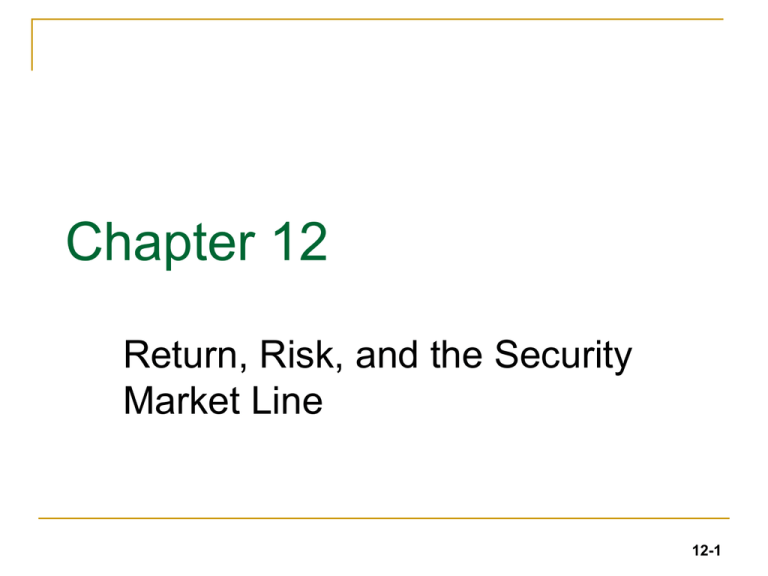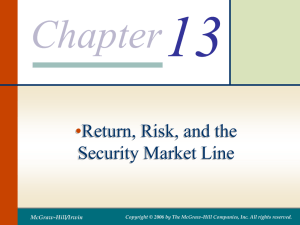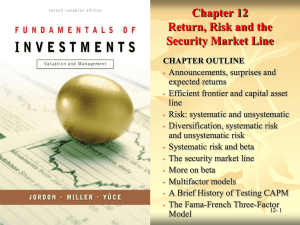Chapter 12
advertisement

Chapter 12 Return, Risk, and the Security Market Line 12-1 Announcements and News • Firms make periodic announcements about events that may significantly impact the profits of the firm. • Earnings • Product development • Personnel • The impact of an announcement depends on how much of the announcement represents new information. 12-2 Announcements & Surprises Total return–Expected return = Unexpected return R – E(R) = U Announcement = Expected + Surprise 12-3 Announcements & Surprises A company announces earnings $1.00 per share higher than the previous quarter. Price Doesn't move Goes up Goes down Indication No surprise Market expected lower earnings Market expected higher earnings 12-4 Systematic & Unsystematic Components of Return (12.3) (12.4) (12.5) R – E(R)=Systematic +Unsystematic R – E(R) = U = m+ε where m = market risk ε = unsystematic risk Total risk=Systematic risk + Unsystematic risk 12-5 Systematic & Unsystematic Components of Return (12.5) Total risk = Systematic risk + Unsystematic risk = Market risk + firm-specific risk If the latest Consumer Price Index numbers indicate that inflation has risen substantially. Will this impact systematic or unsystematic risk? If a company announces that it will have to restate its financials for the last 3 years, which risk component will be affected? 12-6 Diversification and Risk • In a large portfolio: • Some stocks will go up in value because of positive company-specific events, while • Others will go down in value because of negative companyspecific events. • Unsystematic risk is essentially eliminated by diversification, so a portfolio with many assets has almost no unsystematic risk. • Unsystematic risk = diversifiable risk. • Systematic risk = non-diversifiable risk. 12-7 Systematic Risk “Unsystematic risk is essentially eliminated by diversification, so a portfolio with many assets has almost no unsystematic risk.” “The systematic risk principle states that the reward for bearing risk depends only on the systematic risk of an investment.” “The expected return on an asset depends only on its systematic risk.” 12-8 The Systematic Risk Principle • The systematic risk principle states: The expected return on an asset depends only on its systematic risk. • No matter how much total risk an asset has, only the systematic portion is relevant in determining the expected return (and the risk premium) on that asset. 12-9 Measuring Systematic Risk • The Beta coefficient ( ) measures the relative systematic risk of an asset. • Beta > 1.0 more systematic risk than average. • Beta < 1.0 less systematic risk than average. • Assets with larger betas = greater systematic risk = greater expected returns. Note that not all Betas are created equally. 12-10 Risk & Beta Asset 1 Asset 2 Std Dev 25% 45% Beta 1.30 0.80 • Asset 2 has more total risk because it has the greater standard deviation. • Asset 1 has more systematic risk because it has the larger Beta. • Asset 1 should have the higher expected return since it has the larger beta. 12-11 Portfolio Beta n P xi i i 1 Xi = % of portfolio invested in asset i βi = Beta of asset i Asset 1 Asset 2 Wgt 40% 60% Beta 1.30 0.80 Wgt*B 0.52 0.48 1.00 12-12 Portfolio Beta Security Stock W Stock X Stock Y Stock Z $ Invested $1,000 $2,500 $3,500 $1,000 E(R) 7.5% 9.0% 12.0% 10.5% Beta 0.85 0.95 1.20 1.10 What is this portfolio’s expected return and Beta? 12-13 Portfolio Return & Beta Example Step 1: Calculate each stock’s % or weight in the portfolio Security Stock W Stock X Stock Y Stock Z $ Invested $1,000 $2,500 $3,500 $1,000 $8,000 % (wgt) 12.50% 31.25% 43.75% 12.50% 100.00% 12-14 Portfolio Return & Beta Step 2: Apply the weights to each stock’s expected return to arrive at the portfolio’s expected return. Security Stock W Stock X Stock Y Stock Z % (wgt) 12.50% 31.25% 43.75% 12.50% E(R) 7.5% 9.0% 12.0% 10.5% 0.9% 2.8% 5.3% 1.3% 10.3% 12-15 Portfolio Return & Beta Step 3: Apply the weights to each stock’s beta to arrive at the portfolio’s beta. Security Stock W Stock X Stock Y Stock Z % (wgt) 12.50% 31.25% 43.75% 12.50% Beta 0.85 0.95 1.20 1.10 0.106 0.297 0.525 0.138 1.066 12-16 Beta and the Risk Premium, I. • Consider a portfolio made up of asset A and a risk-free asset. • For asset A: E(RA) = 16% and A = 1.6 • The risk-free rate Rf = 4%. Note that for a risk-free asset, = 0 by definition. • Varying the % invested in each asset will change the possible portfolio expected returns and betas. • Note: if the investor borrows at the risk-free rate and invests the proceeds in asset A, the investment in asset A will exceed 100%. 12-17 Beta and the Risk Premium % in A 0% 25% 50% 75% 100% 125% 150% % in Rf 100% 75% 50% 25% 0% -25% -50% Portfolio E( R ) Beta 4.0% 0.0 7.0% 0.4 10.0% 0.8 13.0% 1.2 16.0% 1.6 19.0% 2.0 22.0% 2.4 12-18 12-18 Portfolio Expected Returns and Betas for Asset A 12-19 Beta and the Risk Premium % in B 0% 25% 50% 75% 100% 125% 150% % in Rf 100% 75% 50% 25% 0% -25% -50% Portfolio E( R ) Beta 4.0% 0.0 6.0% 0.3 8.0% 0.6 10.0% 0.9 12.0% 1.2 14.0% 1.5 16.0% 1.8 12-20 12-20 Portfolio Expected Returns and Betas for Asset B 12-21 Portfolio Expected Returns and Betas for Assets A & B Portfolio Return & Beta Portfolio E(R) 25.0% E (RA ) Rf 20.0% A 7.5% 15.0% 10.0% E (RB ) Rf 5.0% B 6.67% 0.0% 0.0 0.3 0.6 0.9 1.2 1.5 1.8 Portfolio Beta 12-22 The Fundamental Relationship between Risk and Return Reward-to-Risk (A) = 7.50% Reward-to-Risk (B) = 6.67% (12.6) E (RA ) Rf A E (RB ) Rf B “The reward-to-risk ratio must be the same for all assets in a competitive market.” 12-23 The Fundamental Result • The situation we have described for assets A and B cannot persist in a well-organized, active market • Investors will be attracted to asset A (and buy A shares) • Investors will shy away from asset B (and sell B shares) • This buying and selling will make • The price of A shares increase • The price of B shares decrease • This price adjustment continues until the two assets plot on exactly the same line. • That is, until: ER A R f ER B R f βA βB 12-24 The Fundamental Result 12-25 Over- and Under-Valued Security Stock W Stock X Stock Y Stock Z E(R) 7.5% 9.0% 12.0% 10.5% Beta 0.85 0.95 1.20 1.10 If the Risk-free rate is 5%, are these stocks fairly valued? 12-26 Over- and Under-Valued Security Stock W Stock X Stock Y Stock Z E(R) 7.5% 9.0% 12.0% 10.5% Beta 0.85 0.95 1.20 1.10 Ratio 2.94% 4.21% 5.83% 5.00% Stocks W and X offer insufficient returns for their level of risk compared to stocks Y and Z. Stock Y offers the highest return for its level of risk. 12-27 The Security Market Line (SML) • The Security market line (SML) = a graphical representation of the linear relationship between systematic risk and expected return in financial markets. • For a market portfolio, ER M R f ER M R f βM 1 ER M R f 12-28 The Security Market Line • The term E(RM) – Rf = market risk premium because it is the risk premium on a market portfolio. E R R i f E RM Rf βi • For any asset i in the market: ER i R f ER M R f βi • Setting the reward-to-risk ratio for all assets equal to the market risk premium results in an equation known as the capital asset pricing model. 12-29 The Security Market Line • The Capital Asset Pricing Model (CAPM) is a theory of risk and return for securities in a competitive capital market. E Ri Rf E RM Rf βi (12.7) • The CAPM shows that E(Ri) depends on: • Rf, the pure time value of money. • E(RM) – Rf, the reward for bearing systematic risk. • i, the amount of systematic risk. 12-30 The Security Market Line (12.7) E( Ri ) Rf E( RM ) Rf i Market Risk Premium Pure time value of money Reward for bearing systematic risk Amount of systematic risk 12-31 The Security Market Line 12-32 Over- and Under-Valued E ( Ri ) Rf E ( RM ) Rf i Rf 5% E ( RM ) 10% E ( Ri ) 5% ( 5%) i Security Stock W Stock X Stock Y Stock Z E(R) Beta 7.5% 9.0% 12.0% 10.5% 0.85 0.95 1.20 1.10 CAPM Return 9.25% 9.75% 11.00% 10.50% Value Over Over Under Fair 12-33 The Security Market Line Security Market Line 14.00% Y 12.00% 10.00% Z E(R) 8.00% X W 6.00% RF = 5% 4.00% 2.00% 0.00% Beta 12-34 Risk and Return Summary, I. 12-35 Risk and Return Summary, II. 12-36 More on Beta (12.8 and 12.4) R - E(R)= m + ε (12.9) m = [RM –E(RM)] x β Systematic portion of the unexpected return on the market M (12.10) R-E(R)= [RM –E(RM)] x β + ε 12-37 Decomposition of Total Return • Suppose the expected return on the market is 10% and the risk-free rate is 5%. • Asset A has a beta of 0.80. • The expected return on Asset A is 9%. • One year the return on the market is actually 8% and the return on Asset A in the same year is 6.5%. Decompose these returns. 12-38 Decomposition of Total Return • E(RM) = 10% • RF = 5% • E(RA) = 9% • • • • Actual RM = 8% βA = 0.80 Actual RA =6.5% UNE(RM)= [RM-E(RM)] = 8% - 10% = -2% UNE(RA) = [RA-E(RA)] = 6.5% - 9% = -2.5% Systematic UNE = [RM-E(RM)] x β = -2% x .80 = -1.6% Unsystematic portion = [RA-E(RA)] - [RM-E(RM)] x β = (-2.5%) – (-1.6%) = -0.90% 12-39 Decomposition of Total Returns 12-40 Unexpected Returns and Beta 12-41 Where Do Betas Come From? • A security’s Beta depends on: • How closely correlated the security’s return is with the overall market’s return, and • How volatile the security is relative to the market. • A security’s Beta is equal to the correlation multiplied by the ratio of the standard deviations. σi β i CorrR i ,R M σm 12-42 Where Do Betas Come From? 12-43 Using a Spreadsheet to Calculate Beta 12-44 Calculating Beta (12.11) Year 2004 2005 2006 2007 2008 Totals Asset H Market Covariance = Correlation= Beta = i Corr(Ri , RM ) i M im i im M M2 Returns Asset H Market (1) (2) 15.00% 10.00% 11.50% 8.00% -4.00% -1.00% 12.50% 7.00% -2.00% 0.00% 33.00% 24.00% Average Returns 33% / 5 = 6.60% 24% / 5 = 4.80% .01751 / 4 = 0044/(.088 x .0497) = .9914 x (.0888/.0497) = Return Deviations Asset H Market (3) (4) 8.40% 5.20% 4.90% 3.20% -10.60% -5.80% 5.90% 2.20% -8.60% -4.80% 0.00% 0.00% Variances .031570 / 4 = 0.007893 .009880 / 4 = 0.002470 0.0044 0.9914 1.77 Squared Deviations Asset H Market (5) (6) 0.007056 0.002704 0.002401 0.001024 0.011236 0.003364 0.003481 0.000484 0.007396 0.002304 0.031570 0.009880 Standard Deviations √.007893 = √.002470 = Product of Deviations (7) 0.0043680 0.0015680 0.0061480 0.0012980 0.0041280 0.0175100 8.88% 4.97% Beta = .0044/.00247=1.77 12-45 Calculating Beta Step 1: Compute average returns for Asset H and the Market Year 2004 2005 2006 2007 2008 Totals Asset H Market Returns Asset H Market (1) (2) 15.00% 10.00% 11.50% 8.00% -4.00% -1.00% 12.50% 7.00% -2.00% 0.00% 33.00% 24.00% Average Returns 33% / 5 = 6.60% 24% / 5 = 4.80% 12-46 Calculating Beta Step 2: Compute variance and standard deviations for Asset H and the Market Year 2004 2005 2006 2007 2008 Totals Asset H Market Returns Asset H Market (1) (2) 15.00% 10.00% 11.50% 8.00% -4.00% -1.00% 12.50% 7.00% -2.00% 0.00% 33.00% 24.00% Average Returns 33% / 5 = 6.60% 24% / 5 = 4.80% Return Deviations Asset H Market (3) (4) 8.40% 5.20% 4.90% 3.20% -10.60% -5.80% 5.90% 2.20% -8.60% -4.80% 0.00% 0.00% Variances .031570 / 4 = 0.007893 .009880 / 4 = 0.002470 Squared Deviations Asset H Market (5) (6) 0.007056 0.002704 0.002401 0.001024 0.011236 0.003364 0.003481 0.000484 0.007396 0.002304 0.031570 0.009880 Standard Deviations √.007893 = √.002470 = 8.88% 4.97% 12-47 Calculating Beta Step 3: Compute the covariance between the Market and Asset H. Year 2004 2005 2006 2007 2008 Totals Asset H Market Covariance = Returns Asset H Market (1) (2) 15.00% 10.00% 11.50% 8.00% -4.00% -1.00% 12.50% 7.00% -2.00% 0.00% 33.00% 24.00% Average Returns 33% / 5 = 6.60% 24% / 5 = 4.80% .01751 / 4 = Return Deviations Asset H Market (3) (4) 8.40% 5.20% 4.90% 3.20% -10.60% -5.80% 5.90% 2.20% -8.60% -4.80% 0.00% 0.00% Product of Deviations (7) 0.0043680 0.0015680 0.0061480 0.0012980 0.0041280 0.0175100 Variances .031570 / 4 = 0.007893 .009880 / 4 = 0.002470 0.0044 12-48 Calculating Beta Step 4: Compute the correlation coefficient and the Beta for Asset H. Average Returns 33% / 5 = 6.60% 24% / 5 = 4.80% Asset H Market Covariance = Correlation= Beta = (12.11) Variances .031570 / 4 = 0.007893 .009880 / 4 = 0.002470 .01751 / 4 = 0044/(.088 x .0497) = .9914 x (.0888/.0497) = 0.0044 0.9914 1.77 i Corr( Ri , RM ) i M 12-49 Why Do Betas Differ? • Betas are estimated from actual data. Different sources estimate differently, possibly using different data. • For data, the most common choices are three to five years of monthly data, or a single year of weekly data. • The S&P 500 index is commonly used as a proxy for the market portfolio. • Calculated betas may be adjusted for various statistical and fundamental reasons. 12-50 Beta - β Beta (β) measures a specific asset’s market risk relative to an average asset. Company Exxon Mobil General Motors IBM Microsoft Wal-Mart Value Line 0.90 1.45 1.10 1.00 0.80 S&P 0.75 1.21 1.62 0.94 0.54 Market Beta = 1.00 Risk-free asset beta = 0.00 12-51 Finding a Beta on the Web 12-52 Company Beta and Return General Motors Wal-Mart Market GM WMT M Value Line 1.21 0.80 1.00 25% 20% 15% 10% 5% 0% 1 GM 2 3 WMT 4 5 MARKET 12-53 Extending CAPM • The CAPM has a stunning implication: • What you earn on your portfolio depends only on the level of systematic risk that you bear • As a diversified investor, you do not need to worry about total risk, only systematic risk. • But, does expected return depend only on Beta? Or, do other factors come into play? • The above bullet point is a hotly debated question. 12-54 Important General Risk-Return Principles • Investing has two dimensions: risk and return. • It is inappropriate to look at the total risk of an individual security. • It is appropriate to look at how an individual security contributes to the risk of the overall portfolio • Risk can be decomposed into nonsystematic and systematic risk. • Investors will be compensated only for systematic risk. 12-55 The Fama-French Three-Factor Model • FF propose two additional factors as useful in explaining the relationship between risk and return. • Size, as measured by market capitalization • The book value to market value ratio • Whether these two additional factors are truly sources of systematic risk is still being debated. 12-56 Returns from 25 Portfolios Formed on Size and Book-to-Market • Note that the portfolio containing the smallest cap and the highest book-to-market have had the highest returns. 12-57 Useful Internet Sites • earnings.nasdaq.com (to see recent earnings surprises) • www.portfolioscience.com (helps you analyze risk) • money.cnn.com (a source for betas) • finance.yahoo.com (a terrific source of financial information) • www.smartmoney.com (another fine source of financial information) • www.moneychimp.com (for a CAPM calculator) • http://mba.tuck.dartmouth.edu/pages/faculty/ken.french/ (source for data behind the FAMA-French model) 12-58








